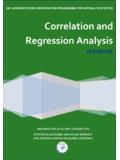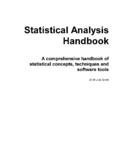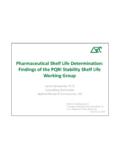Transcription of Rainfall Frequency/Magnitude Atlas for the …
1 Rainfall Frequency/Magnitude Atlasfor the South Central United States byGregory E. FaiersDepartment of GeographyUniversity of Pittsburgh at JohnstownJohnstown, PA 15902 Barry D. KeimDepartment of GeographyUniversity of New HampshireDurham, NH 03824 Robert A. Muller, DirectorSouthern Regional Climate Center Department of Geography and AnthropologyLouisiana State UniversityBaton Rouge, LA 70803 SRCC Technical Report 97 1 Geoscience PublicationsDepartment of Geography and Anthropology Louisiana State UniversityBaton Rouge, LA CONTENTSI ntroductionJustification Geographic Patterns and Relationships to TP40 Rainfall Frequency/Magnitude Maps Appendix Bibliography frequency magnitude relationships of heavyrainfall events are commonly utilized in designprojects by providing useful guidelines toengineers.
2 Planners, and hydrologists aboutfuture expectable storm events. Despite its age,the most widely used publication employingthese relationships is Technical Paper No. 40(hereafter referred to as TP40) by DavidHershfield (1961). TP40 examined extremerainfall events in the United States and provided expectable precipitation amounts forrecurrence intervals from 1 to 100 years fordurations from 30 minutes to 24 hours. Otherpapers addressing this topic include WeatherBureau Technical Papers No. 2 (1947) onmaximum recorded Rainfall from 5 minutes to24 hours at first order stations; No. 24 (1954) Rainfall return periods for 5 minutes to 4 hours;No. 29 (1958) which presents Rainfall intensity duration frequency distributions; No.
3 49 (1964)on 2 to 10 day rainfalls for return periods from 2to 100 years; and Hydro 35 (Frederick et al.,1977) which examines 5 to 60 minute rainfallfor the central and eastern United Rainfall frequency and magnitudepatterns illustrated in TP40 need to bereexamined:* because there are 35 additional years ofprecipitation data since its publication in 1961* because of recent concerns aboutglobal climate change* because of the short periods of recordin TP40 with less than half of the stationshaving more than 15 years of record; and * because of the very generalizedanalysis for the 48 conterminous can also be great spatial variabilityin frequency magnitude relationships over shortdistances, especially in mountainous areas(Haiden et al.)
4 , 1992; Zurndorfer, 1990).Another serious limitation is that sincethe publication of TP40, it has become widelyaccepted that there is no single statisticaldistribution which provides the best fit forextreme precipitation data in all climate regionsof the country (Sevruk and Geiger, 1981; Huff1990). Alternative statistical approaches havealso been suggested in recent publications(Hosking, 199; Huff and Angel, 1992; Wilks,1992; Zwiers and Ross, 1992). Concerns werefurther increased by the findings of Sorrell andHamilton (1989) who found that the 24 hour,100 year value from TP40 was exceeded over 3times more often than expected in Michigan andby Angel and Huff (1991) who found thatIllinois and Wisconsin had almost twice asmany 100 year, 24 hour events as anticipated the South Central United States,extreme precipitation events, and the floods theygenerate have occurred frequently in the 1980sand 1990s.
5 Recent examples include:* June 26 July 1, 1989 Rainfall up to 20inches from Tropical Storm Allison resulted inflooding across Much of Louisiana and portionsof eastern Texas and western Mississippi;* November 7, 1989 heavy rains of upto 19 inches fell in the New Orleans area(NOAA, 1989);* May 18, 1990 13 inches of rain wereobserved in just nine hours at Hot Springs,Arkansas;* October 5, 1991 a 75 minuteaccumulation of 6 inches, along with a 12 houraccumulation of 10 inches, was reported atTuskahoma, Oklahoma;* October 15 19, 1994 storm totals ofnear 30 inches occurred north of Houston and 8 inch storm totals or more were widespreadacross southeastern Texas (Muller and Faiers,1995);* May 8 9, 1995 Rainfall in excess of25 inches fell in parts of Hancock County,INTRODUCTIONM ississippi, with 10 to 20 inches over much ofmetropolitan New Orleans accompanied bysignificant flooding over much of low lyingNew Orleans and Slidell, Louisiana (Muller etal.)
6 , 1995),The question of an increasing frequencyof events in recent decades has also been notedin professional publications and and Stewart (1983) found an unusualnumber of rain events in excess of 10 inches inLouisiana in 1982 and 1983. Widespread recordflooding associated with persistent frontalrainfall was reported during March and April of1990 in eastern Texas and Oklahoma by Jensen(1990). It was also found that recentmagnitudes of New Orleans storms weresignificantly larger than storms over thepreceding 100 years and heavy Rainfall eventsappear to be increasing in frequency (Keim andMuller, 1992; 1993). Muller and Faiers (1984)had found earlier that most record peak stageson rivers in the East Central climate division of Louisiana had occurred since 1973 with anincreasing trend throughout the 1970s and early1980s.
7 Hirschboeck and Coxe (1991) detectedincreases in urban flash flooding in theLouisiana cities of Monroe and Alexandria. Finally, Keim (1997) found an increasing trendin heavy rainfalls at several locations along anaxis extending from northeastern Texas throughthe Appalachians. Collectively, these studies indicate thatexcessive Rainfall and flooding events werebecoming more common in the South inthe recent past, especially in the 1980s and early1990s. Impacts of these extreme eventsincluded disruption of transportation systems,river basin flooding, inundation of farm landsand homes, loss of life, thus creating an obviousneed for evaluations of the temporal and spatialcharacteristics of extreme rainfalls across thisregion (Fig.)
8 1).Fig. 1. the six state region of the Southern Regional Climate CenterSeveral of the Regional Climate Centers (RCCs)have undertaken re evaluations of extremerainfall frequency magnitude relationshipswithin their respective regions (Changnon et al.,1992; Huff and Angel. 1992; Knappenbergerand Michaels, 1993; Wilks and Cember, 1993).A pilot study was also undertaken by theSouthern RegionalClimate Center (SRCC) to evaluate extremerainfall frequency magnitude relationshipsacross the state of Louisiana (Faiers et al.,1994a). In this study, methods used weresimilar to those employed in TP40, but longerperiods of record, including data through the1980s and part of the 1990s, were used to derivethe quantile estimates; quantiles are estimatesrepreseting return periods and associated stormmagnitudes.
9 Patterns from the updated maps forLouisiana were compared to those in TP40 ( ). Overall storm magnitudes did not varygreatly between the two studies, but the SRCC product depicted a more complex spatial patternwith shifts in the regions of extreme rainfallmaxima from southeastern to findings from this pilot study, aswell as results from other regional studies,verified the need for a regional format across thesix state region of the SRCC, and for greaterspatial resolution of the expected extremerainfalls than depicted in TP40. Furthermore, frequency magnitude relationships of extremerainfall have had a high user demand, rankingamong the most commonly requested data setsat the SRCC.
10 As a result, deriving accuratefrequency magnitude estimates of extremeprecipitation across the six southern states of theFig. 2. Twenty four hour 2 year rainfalls inLouisiana according to the Technical Paper No. 40and our updated version using similar : Faiers et al., 1994a. JUSTIFICATIONSRCC (Fig. 2) became part of the researchagenda at the SRCC. This research yieldedmore regionally representative estimates thanTP40, and it should support improved drainageand containment designs. This documentsummarizes the new estimates of therelationships for durations of 3, 6, 12, and 24 hours for 2 , 5 , 10 , 25 , 50 , and 100 year return periods with regional scale sections describe the geographical patternsand the primary differences to TP40.






